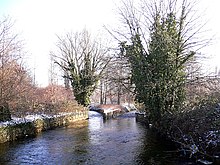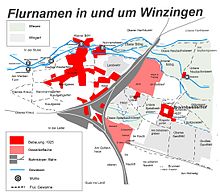Winzingen (Neustadt)
|
Winzingen
City of Neustadt an der Weinstrasse
|
|
|---|---|
| Coordinates: 49 ° 21 ′ 13 ″ N , 8 ° 8 ′ 58 ″ E | |
| Height : | 132 m above sea level NHN |
| Incorporation : | 1892 |
| Postal code : | 67433 |
| Area code : | 06321 |
|
Neustadt-Winzingen district
|
|
Winzingen used to be a winegrowing village . It was in the 1892 Palatine town of Neustadt an der Haardt, today Neustadt an der Weinstraße ( Rhineland-Palatinate ) incorporated . In the meantime, Winzingen only has the quality of a district, so it no longer legally counts as an incorporated district . In the Middle Ages , the village at that time gave its name to Winzingen Castle, 2 km to the northwest .
Geographical location
The district is located east of the historic town center of Neustadt and essentially south of the Speyerbach . The 1.5 km long Floßbach flows into this in the north of Winzingen from the left . Branch off from the Speyerbach to the west of the city center, it flows first through the north of the city center and then through Winzingen.
200 m east of its mouth, on the northeastern edge of Winzingen in what is now the residential area of Böbig, the Rehbach has been diverted to the left with a third of the amount of water from the Speyerbach since the late Middle Ages . The separating device is called Winzinger Wassergescheid .
At the northern edge of Winzingen, the federal highway 38 runs as Maximilianstrasse , which connects the Neustadt west with the junction 12 Neustadt-Nord of the Autobahn 65 ( Ludwigshafen - Karlsruhe ).
history
timeline

In connection with donations to the Weißenburg monastery , the place was first mentioned in 774 under the name "Wincingas", namely in a document cited in the Codex Edelini . The actual foundation by the Germanic tribe of the Franks probably took place earlier. The name “Wincingas” could be derived from the Latin words vinum (wine) and cingere (girdle). The name (villa) vincincta means wine (mountain) girded settlement and would be a reference to the viticulture that has been practiced in the region since Roman times .
Winzingen is much older than the "New City", which was called Neustadt an der Haardt until 1936 and from 1945 to 1950 . When Neustadt was founded in the early 13th century by Count Palatine Ludwig I and his son Otto II , the settlement of Winzingen belonged to their castle of the same name , which was built in the 10th century 2 km northwest on the slope of the Haardt and is now a ruin. The image of the castle also shaped the earlier coat of arms of Winzingen. When the city was founded, the municipality of Winzingen lost part of its independence and from then on belonged to the "Neustadter Bann". At that time the settlement was 1 km below the Speyerbach, i.e. east of the new foundation.

The Old Winzinger Church , which is still preserved today , is the oldest church in Neustadt, was built in the 13th century in the Gothic style and was dedicated to St. Consecrated to Ulrich ; It was first mentioned in a document in 1281. Archaeological finds indicate a previous building from the Carolingian period. After the Reformation , the building became the property of the Reformed , which was finally sealed in 1705 when the Palatinate church was divided.
At the end of the 18th century, the Winzinger area had 97 acres of fields, 41 acres of vineyards, 30 acres of meadows and 2 acres of gardens. The community did not have its own forest, but had rights in the Neustadter Geraiden. In 1869 there were 733 residents in Winzingen in 181 families, spread over eight places. The last census before incorporation recorded 54% Protestants, 41% Catholics and 5% members of other denominations. The 1116 inhabitants of the 213 hectare community area were spread over five districts, namely the hamlets of Bannmühle and Branchweiler , the individual properties Böbig and Wiesenmühle and the church village of Winzingen. When it was incorporated - the last mayor was the brickworks owner Ludwig Häusser - Winzingen had 1,282 residents who lived in around 15 different streets and alleys as well as on the Branchweilerhof and in the Bischofsmühle.
During the time of National Socialism , Pastor Martin Niemöller gave a widely acclaimed speech on April 22, 1937 in the Alte Winzinger Church at the invitation of the Pastors' Emergency Association. Shortly before the end of the Second World War , the church tower was destroyed on March 21, 1945 by a grenade with which the German defense wanted to stop the advancing US troops.
Schultheiße in the 17th century
- After 1639 and before 1649 the office of mayor was Johann Christoph Römmich ("died 1674 Römmich, old mayor of Winzingen").
- 1687 worked as mayor Johann (Hans) Valentin Ebel ("died 1694, 75 years old, formerly mayor of Winzingen").
- In 1699, Mayor Lachmann is mentioned.
Mayor and adjuncts 1815–1891
After the end of the Napoleonic Wars and to the incorporation of the following were mayors and their adjunct named deputy in office.
| time | mayor | job | Adjunct | job |
|---|---|---|---|---|
| 1815-1834 | Christian Adam Schimpf | Ziegler | 1819 Gerhard Janson | Landowner on the Branchweilerhof |
| 1835-1848 | Johann Philipp Schaaf | Landowner and innkeeper | (Johann) Georg Lorch | Red tanner, landowner |
| 1841 (VIII) | Jacob Deidesheimer | Ziegler | ||
| 1841 (IX) | Ludwig Lieberich | Müller, owner of the Kronenmühle | ||
| 1846 (VI) | Martin Hauser | Brick factory owner | ||
| 1846-1868 | Martin Hauser | Brick factory owner | Heinrich Schmidt | |
| 1853-1860 | Jacob Winter Sr. | wagner | ||
| 1860-1863 | Heinrich Mattil | Müller | ||
| 1863 | Nikolaus fuck | Carpenter | ||
| 1868-1886 | Johann Philipp Riel | Gerber, miller, owner of the Bischofsmühle | Heinrich Schmitt II | |
| 1877 | Philipp Bernhard | |||
| 1880-1888 | Nikolaus Mallrich | Owner of the meadow mill | ||
| 1888-1891 | Ludwig Hauser | Brick factory owner | Johann Alder Wine | Cooper master |
Economy and Infrastructure
economy
The starch factory J. Neubauer & Co., founded by Jacob Neubauer in Neustadt in 1849, moved to Winzingen to the Mönchshof in 1854, where it was operated until around 1920. In addition to wine and arable farming and meadow cultivation, the mill economy determined the economic income of Winzingen for a long time. At the end of the 20th century, some of the locations developed into larger companies, such as the barley factory and art mill in Lieberich and the Friedrich Helfferich textile factory .
The Palatinate Ludwig Railway ( Ludwigshafen –Neustadt– Kaiserslautern ), opened in 1847, passed Winzingen to the east and cut up the corridors in and near Winzingen. The Maximiliansbahn (Neustadt - Landau - Wissembourg ), built in 1855, was able to travel from 1887 to 1998 over a triangle of tracks without head stop in Neustadt Hbf. Directly in the direction of Ludwigshafen. Since the beginning of 1900, important companies have settled east of the track, such as Wayss & Freytag and the Internationale Baumaschinenfabrik , as well as the gas and electrical works and the slaughterhouse.
Especially after 1945, the city grew further east beyond the old Winzingen and together with Branchweiler.
Road traffic
Important roads that connect Winzingen to urban and regional traffic are Martin-Luther-Strasse ( Kreisstrasse 23) and Winzinger Strasse in a north-south direction and Konrad-Adenauer-Strasse and Hindenburgstrasse in a west-east direction / Branchweilerhofstrasse.
Festivals
In the middle of Winzingen, between the Floßbach (left) and the Speyerbach (right), lined with poplars , lies the festival meadow in a depression that was formerly threatened by flooding and was therefore not built on with houses . Until 2008, the Winzinger Kerwe took place there every year at the turn of the month between June and July . This event, which emerged from a parish fair, was the second largest folk festival in Neustadt after the German grape harvest festival with more than a hundred showmen and rides . In 2011 the final end was announced because the wine festivals in the area had drawn too many visitors.
Sons and daughters of the place
- Johann Heinrich Hochdörfer (1799–1851), Protestant pastor, early socialist and publicist
- Ludwig Seligman (1813–1879), district rabbi in Kaiserslautern
- Ernst Domke (1882–1945), politician (SPD)
literature
- Address books Neustadt an der Weinstrasse and the surrounding area . Editions 1891, 1896, 1901, 1908, 1914/15 ( dilibri.de [accessed on May 16, 2016]).
- Directory of civil servants and statistics of the Royal Bavarian Administrative Region of the Palatinate: a compilation of civil servants and employees in the state, church and community services, medical staff, military authorities, railway officials, support and charitable institutions, associations, insurance companies, etc., along with a statistical one and local history appendices; a handbook for office and private use . Editions 1874, 1877, 1880, 1883, 1886, 1888 ( dilibri.de [accessed on May 16, 2016]).
- Paul Habermehl: The city of Neustadt around 1700 according to old maps and plans . In: City of Neustadt an der Weinstrasse, city archivist Klaus-Peter Westrich (Ed.): Neustadt an der Weinstrasse . Contributions to the history of a city in the Palatinate. Neustadt 1975.
- Eberhard Ref: Palatinate mill dictionary . ( eberhard-ref.net [accessed on May 10, 2015]).
- Werner Schreiner: Neustadt, a hub in the public transport network . The development of rail and bus connections in the Palatinate metropolis. In: City of Neustadt an der Weinstrasse, city archivist Klaus-Peter Westrich (Ed.): Neustadt an der Weinstrasse . Contributions to the history of a city in the Palatinate. Neustadt 1975.
- Klaus-Peter-Schröder: Considerations for founding Neustadt an der Weinstrasse . In: City of Neustadt an der Weinstrasse, city archivist Klaus-Peter Westrich (Ed.): Neustadt an der Weinstrasse . Contributions to the history of a city in the Palatinate. Neustadt 1975.
- Johann Goswin Widder : Attempt of a complete geographical-historical description of the Electoral Palatinate on the Rhine . tape 2 . Frankfurt and Leipzig 1786.
Individual evidence
- ↑ a b Old Winzing Church. Martin Luther parish Neustadt an der Weinstrasse, accessed on June 29, 2014 (typo “1750” instead of correct “1705”).
- ^ Karl von Rasp (Carl Rasp): Localities directory of the Kingdom of Bavaria. According to government districts, administrative districts .. Munich 1888, p. 420 ( digital collections of the Bavarian State Library ).
- ↑ Old Winzinger Church. Friends of the memorial for Nazi victims, accessed on June 29, 2014 (with historical photo).
- ^ Rolf Sperber: Off for the oldest folk festival. In: Lampertheimer Zeitung . January 19, 2011, accessed May 16, 2016 .




